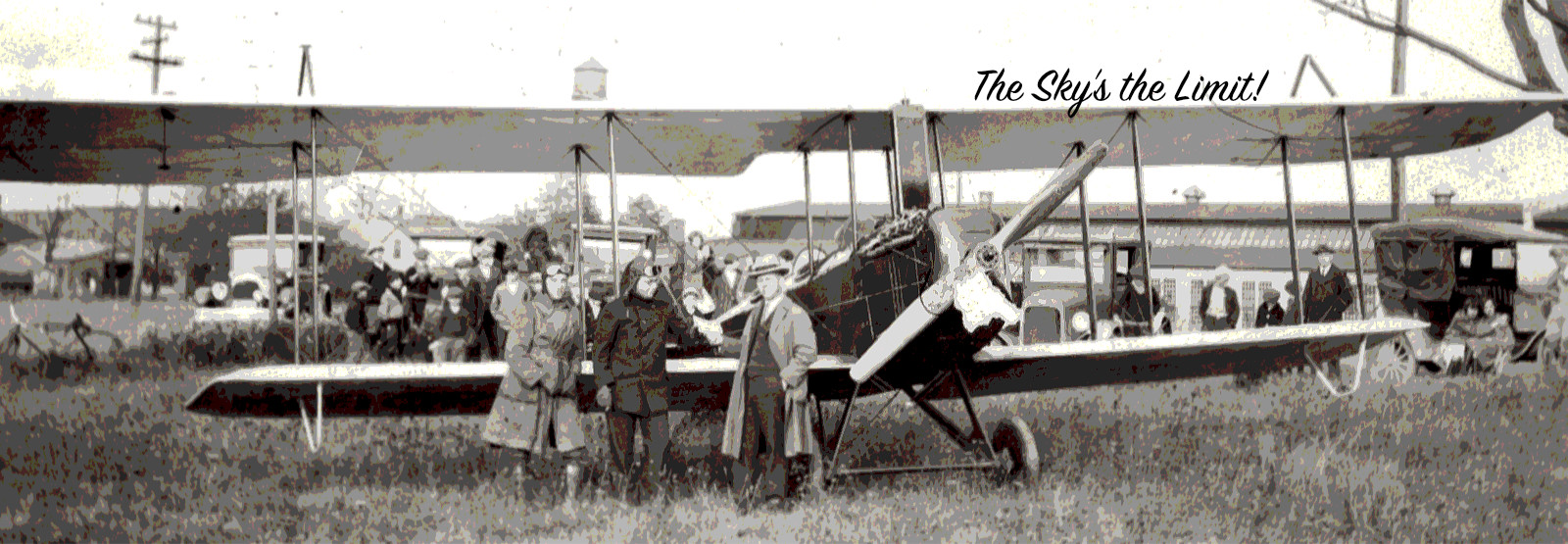

Sparta Township
Capt. Charles E. Belknap
the Blacksmith Congressman
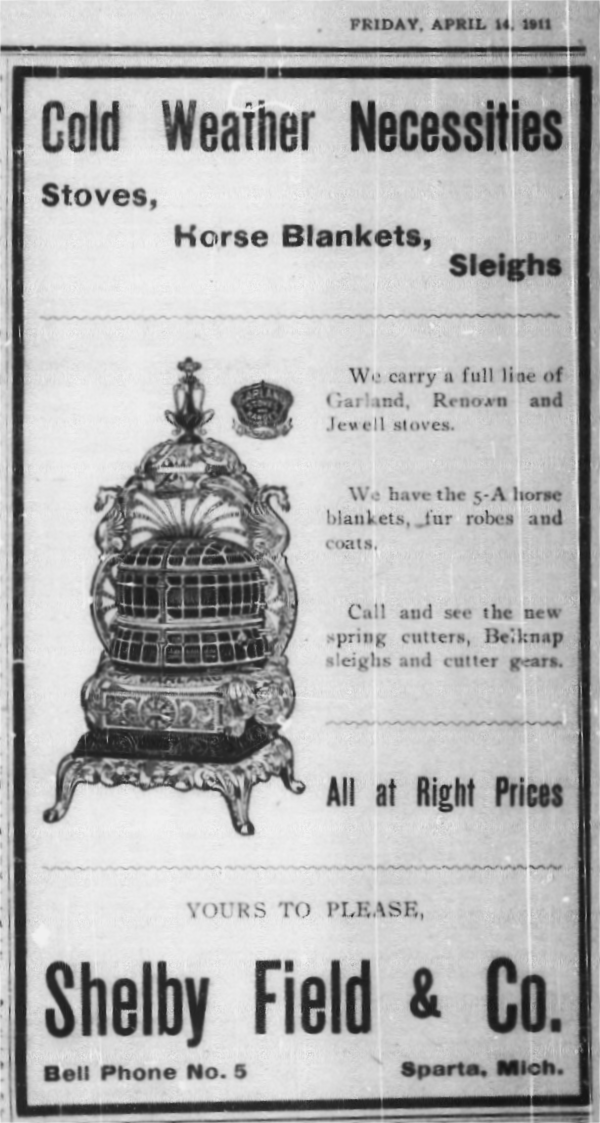
Shelby Field & Co. advertisement for Belknap Sleighs and Cutters from the Sparta Sentinel-Leader on 14 Apr 1911
Editor's note: Arzie Pinckney wrote a story about his memories of hitching a ride on the back of a horse-drawn sleigh at Christmastime on the streets of Sparta when he was young. While searching for a photo of a sleigh, I happened upon not only the story of the sleigh, but of the man who built them.
Reading through old Sparta newspaper advertisements and auction notices, it is clear that one of the most popular sleighs--if not the most popular--sold in the village was a 'Belknap'. Interestingly, the patented sleighs were built nearby in Grand Rapids at the Belknap Wagon and Sleigh Company, a large four-story factory on the west bank of the Grand River at First Street and Front Avenue founded by Charles Eugene Belknap. Does the name ring a bell?
It should if you're familiar with Grand Rapids, Michigan.
Born on October 17th, 1846, at Massena in St Lawrence County, New York, Charles traveled to Michigan in 1854 with his parents, James Albert & Mary Ann (Butler) Belknap, and family. "We came to Michigan because the government had given my grandfather a quarter-section of timber land as a reward for his services in the war of 1812," Charles later wrote in The Yesterdays of Grand Rapids. The Scottish grandfather, John Joshua, served in Captain Flanders' Company of New Hampshire Volunteers and his bounty land was located on the Ottawa County side of Kenowa Avenue at Jamestown (Section 6).
"Father came to do the iron work on the boats being built in the shipyard." The family's arduous journey "by stage, river, canal, lake, and railroad" led to Chicago, "then known to the Indians as Chi-cog--"skunk water." In the getaway from this rightly named place we secured passage on a lumber schooner for Grand Haven, sleeping on the deck without blankets; then by steamer to Grand Rapids." Upon their arrival, the father, a master blacksmith, forged his trade near where the Pantlind Hotel would later stand sentinel alongside the Grand River. A few years later, James relocated his business across the river.
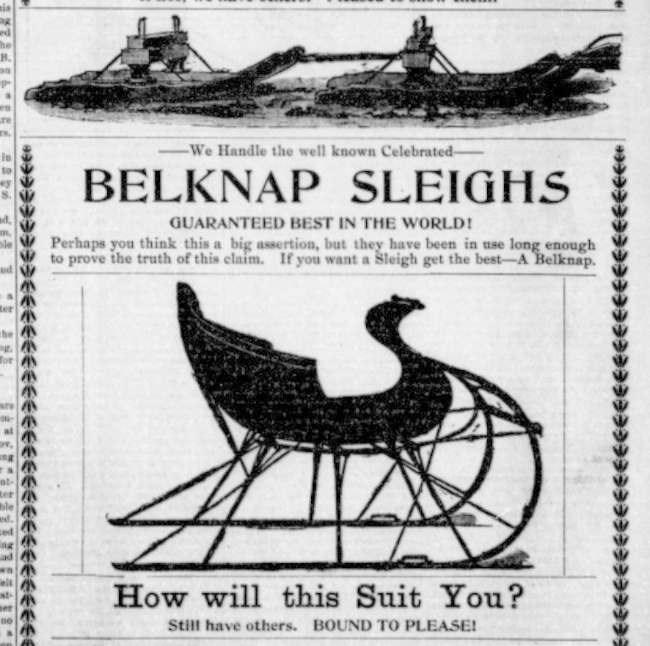
By 1900, Captain Belknap was the second largest manufacturer of sleighs in the United States. The "Celebrated Belknap Sleighs--Guaranteed Best in the World!" ad was published on 2 Dec 1898 in The Evart Review
The son apprenticed with his father and learned the trade. The first volume of Williams' Grand Rapids Directory, City Guide, and Business Mirror compiled by C.S. Williams in 1859 listed the thirteen year-old as a "blacksmith". At the outbreak of the Civil War, James closed his forge and enlisted into Company H of the 8th Michigan Infantry. "Too young," was the response when Charles attempted to join, so he reopened his father's business and pressed on.
Unwilling to give up, Charles convinced his mother to grant her permission for him to join the Army in exchange for a promise he would avoid tobacco, whiskey, and card playing. On August 12, 1862, just two months short of his sixteenth birthday, Charles mustered in at Ionia to serve with Co H of the 21st Michigan Volunteer Infantry as a Private. Over the next thirty-four months, he was in no less than sixty-three skirmishes and received seven wounds: three at Stone River where he rescued his regiment flag when the color bearer was shot; and four additional times at the Battle of Chickamauga--"where the bullets fell thickly". Recognized for courage, Charles swiftly rose to the rank of Captain by the spring of 1864, at just seventeen years of age. He was mustered out in June of 1865 after the war ended and planned to make a career in the military. Weeks later, he passed an exam and was offered the position of first Lieutenant in the cavalry, but with a change of heart he decided to turn it down.
Charles was needed at home.
James also survived the war but suffered multiple severe battle injuries. Captain Belknap returned to west Michigan and rejoined his father in the smithy profession. From raw material to finished product, Charles was a skilled tradesman. Business listings for "Belknap Capt. Charles E., blacksmith" with a second in his name as an "iron forger" and "Belknap, James A., blacksmith" appeared alongside Charles' brother, "Belknap, John J., printer" in the 1865 Grand Rapids City Directory, all at "17 Water". However, it soon became apparent the father's afflictions would necessitate his retirement.
A decision was made to sell the Water Street property and a farm was purchased from Andrew Myers in Sparta Township. At Christmastime in 1866, Charles, a resident of Sparta, married Miss Chloe Mabel Caswell. The 1867 Holland's Grand Rapids Directory confirmed James and Charles had left the city where John remained and worked as a pressman at the Daily Eagle while he boarded at 16 Turner Street.
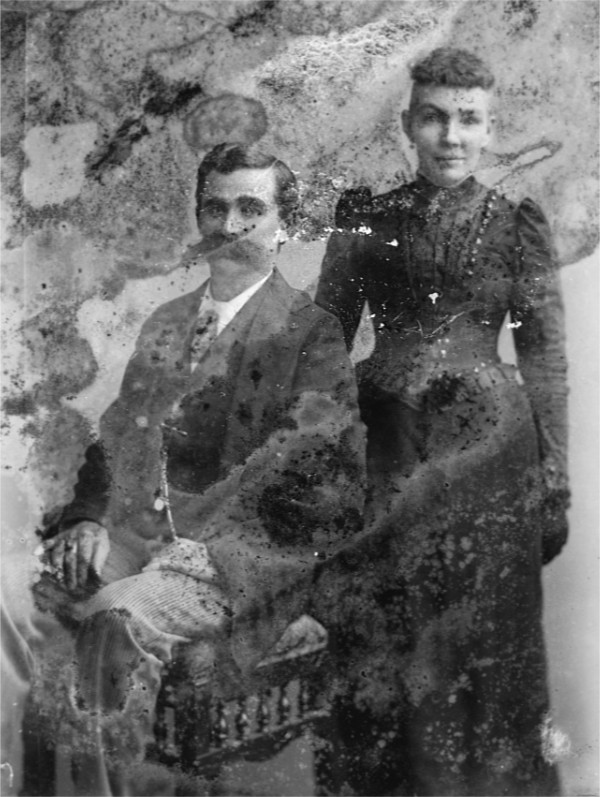
Congressman Charles and Chloe Belknap portrait by C.M. Bell Studio taken in Washington DC (1891)--courtesy of the Library of Congress
The newlyweds soon began their family with three of their four daughters born at Sparta: Bertha in October 1867, Helen in August 1869, and Jennie in August 1870. Birth records stated Charles was a farmer and blacksmith. The youngest daughter, Grace, joined the family in July 1872 at Grand Rapids.
According to the Dillenbeck & Leavitt 1870 Kent County History and Directory, the Belknap farm was located in Section 24 of Sparta Township. It was the 80 acre parcel on what is now 250 13 Mile Road just west of Hiram Myers' farm and Myers Schoolhouse. On August 27th, 1870, the enumeration of the Federal Census valued Charles' farm at $4,500 and his personal property as an additional $1,300. He raised 225 bushels of winter wheat, 100 bushels each of Indian corn and oats. The Belknap farm produced 13 bushels of peas and beans, 100 bushels of Irish potatoes, fruit, 400 lbs of butter, and 20 tons of hay. His parents and youngest brother, Herbert Pengally Belknap, also resided on the Sparta Township farm. With the help of a brother-in-law, Hiram Caswell, Charles farmed while his father had "no occupation".
Three days later, James passed away.
In the following year, after his father's death, Charles exchanged his plow for a full-time forge as the Belknap family returned to Grand Rapids, but it took another year for their farm to pass into the hands of new owners. From a copy of the deed dated 23 Apr 1873, Charles and Chloe sold their 80 acre Sparta farm for $3,000 to Edgar S. Dart of Farmington in Oakland County, Michigan. Mr. Dart increased the size of the farm to encompass 120 acres and remained there until shortly after 1900. The next owner was John G. & Carrie (Anderson) Johnson--and the family owned the farm for the next 100 years.
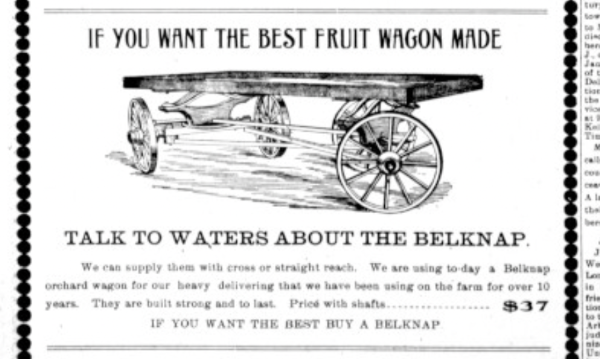
With a price tag of $37.00, Belknap's innovative Orchard Wagon was one of more than three dozen styles of speciality wagons his company manufactured as seen in a 13 Jul 1906 advertisement from Paw Paw's True Northerner
While at Sparta, the Belknap neighbors included: Thomas Myers, James Shangle, Abram Tufflemire, Joseph Clackner, Levious Withey, brothers Frederick and Marcene Cummings--most of whom were also Civil War veterans. Tufflemire, Shangle, and Fred Cummings were in the 1st Michigan Engineers Co., a unit with which Charles spent time assisting early on in his tour. Sabra, the wife of Marcene Cummings, was the sister of Lieut. Amherst B. Cheney, also of the 21st Michigan Infantry. (See the Civil War Letters written by Cheney.) Joseph Clackner Jr. was a Sergeant in the same company of the 21st as Charles.
Even though Charles made the decision to leave, a life-long fondness for Sparta and friendships remained.
Establishment of his rightful place among the iconic manufacturing companies positioned along the banks of the Grand River came about quickly. "In 1871 we find Charles E. Belknap blowing the bellows at the forge and shoeing horses. Shortly afterwards wagons are made at this smithy," Albert Baxter wrote in History of Grand Rapids Michigan (1891). "In 1884 we find the Belknap Wagon and Sleigh Company organized, with an authorized capital of $100,000, for the manufacture of Farm, Freight and Express Wagons; Lumber, Mill and Farm Carts, and Logging Carts and Trucks, with Chas. E. Belknap, President and Manager, and H.P. Belknap, Secretary and Treasurer. The present works on North Front street, give employment to about 50 men."
His successful firm expanded to include structures on both sides of Front Avenue while the number of employees increased to more than 100 men.
In addition to his industrial pursuits, Mr. Belknap was a founder of the Grand Rapids Fire Department and rose to prominence in politics: the board of Education, Alderman, Mayor, board member of the School for the Deaf at Flint, and he served two terms as the Michigan 5th District United States Congressman.
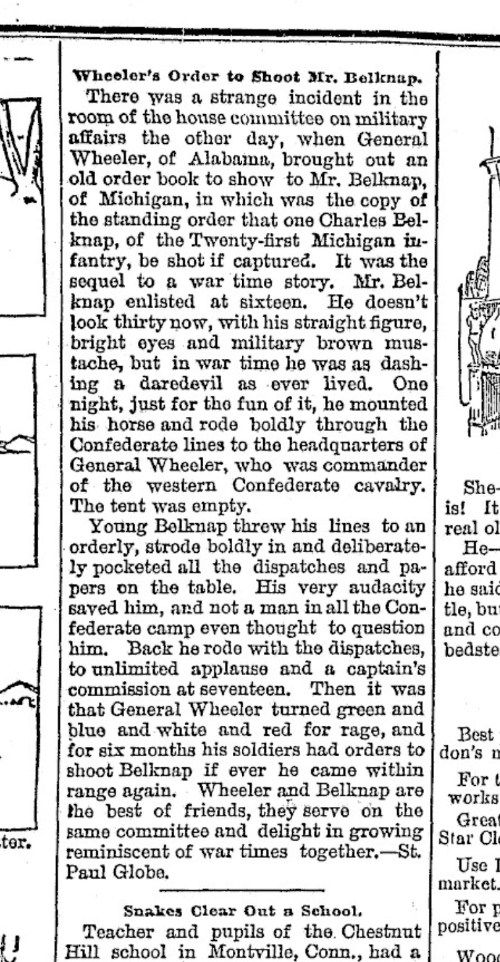
General Wheeler's order to shoot Captain Belknap from the 16 Jul 1892 Cheboygan Democrat, reprinted from the St. Paul Globe
- Wheeler's Order to Shoot Mr. Belknap
published on 16 Jul 1892 in the Cheboygan Democrat
There was a strange incident in the room of the house committee on military affairs the other day, when General Wheeler of Alabama, brought out an old order book to show to Mr. Belknap, of Michigan, in which was the copy of the standing order that one Charles Belknap, of the Twenty-first Michigan infantry, be shot if captured. It was the sequel to a war time story. Mr. Belknap enlisted at sixteen. He doesn't look thirty now, with his straight figure, bright eyes and military brown mustache, but in war time he was as dashing a daredevil as ever lived. One night, just for the fun of it, he mounted his horse and rode boldly through the Confederate lines to the headquarters of General Wheeler, who was commander of the western Confederate cavalry. The tent was empty.
Young Belknap threw his lines to an orderly, strode boldly in and deliberately pocketed all the dispatches and papers on the table. His very audacity saved him, and not a man in all the Confederate camp even thought to question him. Back he rode with the dispatches, to unlimited applause and a captain's commission at seventeen. Then it was that General Wheeler turned green and blue and white and red for rage, and for six months his soldiers had orders to shoot Belknap if ever he came within range again. Wheeler and Belknap are the best of friends, they serve on the same committee and delight in growing reminiscent of war times together.--St. Paul Globe.
Beyond his years in Congress, Charles continued at the helm of his business until retirement in 1916, amid a variety of appointments to serve in various civic and government capacities.
The Captain was generous with his time and became a popular keynote speaker primarily on the topics of history and patriotism for a variety of audiences of all ages such as: the American Legion, Boy Scouts, and school children, to name a few and he returned to Sparta for banquets or other events. In 1952, Carol Holmes-Kurtz fondly recalled him in her Sentinel-Leader column "Seeing Life" when she wrote: "As a child we remember Captain Belknap coming to school to talk to us in assemblies. He was one of our heroes as youngsters."
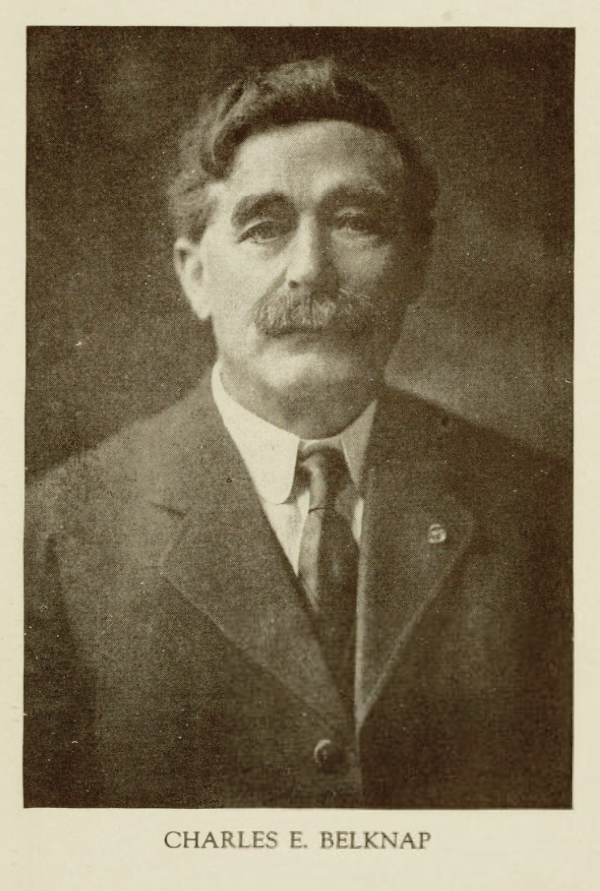
Author Charles E. Belknap portrait from his book, The Yesteryears of Grand Rapids--courtesy of the Library of Congress
His knowledge and passion for history inspired him to pen a series of articles which were part memoir blended with local history that appeared in newspapers--and later in book form as The Yesteryears of Grand Rapids, published in 1922. Not exclusive to the city, the author included vivid tales and insight into the early days on the Rouge River--and even mentioned some of his Sparta Township friends:
"Following the winding river it was a long paddle to the home of that good man, Dr. Sexton, who was an angel of mercy to all the inhabitants of cabins and mill shacks of northern Kent. A "God bless you" often paid the bill. It was all the pioneer could offer."
"At the last mill site on the river sprang up the town of Gougeburg," in Algoma Township's Section 28 where a dam once crossed the Rouge and a sawmill was erected by C.C. Comstock of Grand Rapids. "It never had or needed any other name. Besides its logging crews there were two lawyers, said by the lumberjacks to be hiding from the sheriff. When not tipping the jug they wove shingles and in public spirited way helped the town live up to its name."
"If a man succeeded in escaping from Gougeburg he reached beyond to the Meyers settlement, lying between the river and Camp lake; Hiram, Tom, Ben and Andrew, four brothers, three of them with large families, had come to stay and were making farms," all of whom were former neighbors Charles knew well. (The family is featured in the story of Meyers Schoolhouse.) "It was often said that no man ever went away from Hiram Meyers' homestead hungry and that Auntie Nicholas Emmons in their cabin on Camp lake served the most delicious fritters and maple syrup that man or boy ever tasted."
"At the far end of Camp lake was Snow's tavern. From here crows flying north carried haversacks with frogs for rations, for it was the jumping off place until the trail reached the Muskegon river."
On the 16th of January, 1929, Charles Belknap passed away--a greatly admired man that once called Sparta his home who left his mark on history. A bronze statue was dedicated to his memory in 1931 which is currently located at the intersection of Coit Avenue and Hastings Street in Grand Rapids. The memorial was Erected by friends who admired Captain Belknap's patriotic public services, his winsome friendliness, and simplicity, and the practical Christianity of his exemplary life.
One family's encounter with the Captain left a lasting impression--spanning a century--which truly speaks to the quality of Charles' character. "My father told me, as a young lad, he met Capt. Belknap. It was about 1920 when my father was with his grandfather, James B. Page (a Civil War veteran)," Michael Page related the memory handed down from his father, Charles P. Page. "Capt. Belkap said something to the effect of: Wow. You are the grandson of Jim Page? It's an honor to meet you. My father said Capt. Belknap made him feel important, special... something he remembered for the rest of his life. With all of his accomplishments (Civil War dare-devil, skilled businessman, farmer, politician, etc.) Capt. Belknap took the time to show kindness to a young boy and his grandfather. That is the kind of man Capt. Belknap was."
The Incredible
Dr. Sexton
What does the War of 1812, a doctor, a shipwreck, and a ghost town all have in common? At Sparta Township, the answer is a man named Dr. Isaiah Bliss Sexton.
Bliss greeted his parents, Charles and Abigail (Butler) Sexton, for the first time on July 18th in 1805 at the tiny town of Lowville, Lewis County, New York.
Shortly after the War of 1812 broke out, Charles entered Captain Moses Water's Company in Z. Carter's 101st Regiment of the New York Militia in March of 1813. Six months later, eight-year old Bliss joined his father as he enlisted to serve as a waterboy in September at Putnam, New York. Charles attained the rank of an "Orderly Sergeant" while Private Isaiah's pension declaration indicated he was a "Waiter". But I'm getting ahead of myself.
As a young man, Bliss lived at Otsego County, then a year later in 1825, he removed to Onondaga County, New York, where he wed Abigail North. He first came to Michigan in 1833 to Washtenaw County where he sought a new life. Sorrow cast a shadow on their home at Ypsilanti as Bliss' wife and two children died.
Back in New York, he married Eliza A. Everett, but Bliss was drawn to the mitten state. A sister, Phyla, and her husband, Simeon Rouse, lived at Alpine Township in Kent County. In 1847, Bliss appeared at Grand Rapids where he practiced medicine. The couple returned to New York where family still lived, and in 1850, he was enumerated as a "Physician" at Orleans in Jefferson County. His father, a "Miller", was nearby.
Charles' record as an officer during the war provided him with multiple parcels of bounty land in Michigan. He and Bliss, along with another sister and brother-in-law, Wealtha and Ichabod Gaylord Field, made the journey to Sparta. On the first of April, 1851, the elder Sexton patented a choice parcel provided for his service in the War of 1812; 40 acres fronting Pine Island Drive and Scott Lake.
Bliss took a job in 1852 herding cattle north on the "Newaygo trail" to Grand Traverse after which, "I embarked on the schooner J.Y. Scammon for Chicago," Bliss recounted in an 1896 interview with The Grand Rapids Press. "The schooner was wrecked in a storm and driven on the beach of South Manitou island. The vessel was driven so far up on the shore that we were eventually able to get on dry land without wetting our feet. The day after the wreck I got my baggage into a row boat and hired an Indian and a white man to row me around into the harbor. From there a passing steamer was hailed and I eventually reached Chicago safe and sound."
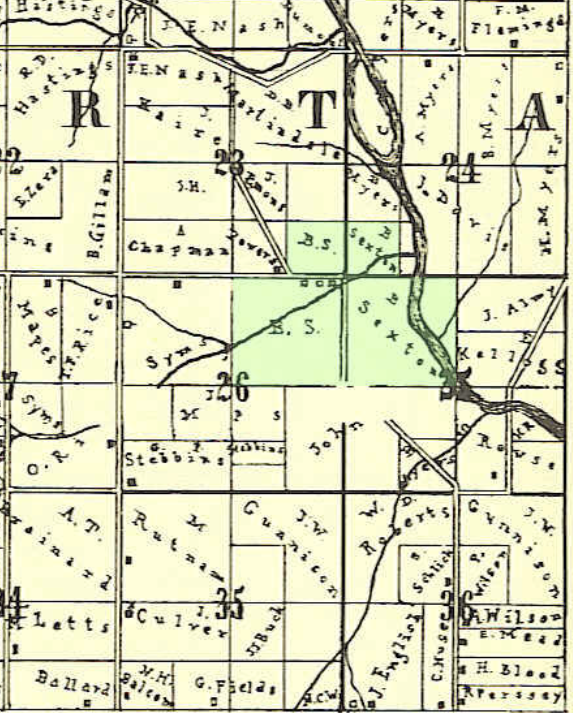
1855 Sparta Township map with Dr Bliss Sexton's property highlighted and future location of Sextonville.
Bliss soon re-established his medical practice and became the Sparta Township tax collector. He acquired two-and-a-half quarter sections at what is now the intersection of Twelve Mile Road and Alpine Avenue, where he made his home. In May of 1855, the doctor purchased 120 acres of land north of what is now 20 Mile Road between Sparta Avenue and Tyrone, at a time just prior to when the townships were separated.
Time moves slowly in Congress. Forty-five years after the start of the "War with Great Britain, declared by the United States on the 18th day of June, 1812," Washington DC approved a "Certificate of Allowance" for his expenses incurred during the war, which included: clothing items, blanket, a musket, bayonet, sword and belt, boots, and transportation. Charles Sexton appeared before L.S. Ballard, Justice of the Peace, on the 5th of November 1857, to certify his claim in the amount of $68.50. On the same day, the son, Isaiah B. Sexton, also filed his declaration for "Twenty one dollars". Charles died several months later.
As the 1860 Federal Census was enumerated at Sparta, Bliss gave his occupation as a "Botanist Physician". In addition to his career in the healing arts, Bliss played a key role in putting Sparta on the map, literally. The doctor envisioned the establishment of roads through the Northern Kent County wilderness; east to west from Muskegon to Cedar Springs, as well as north and south, from Englishville to Croton. During the 1860s, he organized people in favor of the proposal and successfully petitioned the state legislature to get the roadways built.
As Arzie Pinckney wrote in his I Remember column from a 1964 issue of The Sentinel-Leader, "The good Dr. Sexton got angry at some of the businessmen in Sparta and vowed that he would build a town that would take all the business away from Sparta and that the grass would grow on Sparta's Main Street." Exactly what led to the falling out, I cannot say. But Bliss did his best to make good on his threat.
Since he already owned about 400 acres at 12 Mile and Alpine, on both sides of the streets that abutted the Pere Marquette Railroad, he platted it out for development. "He built several small store buildings and houses on the north side of the road beginning at Alpine (where the Gerhardt Seelman and Gene Dancer residences were located in 1964). Some of the buildings were still standing until not too many years ago, but they were left to deteriorate and finally fell down while Sparta continued to do business as usual."
Arzie continued, "The Doctor had given his town a real name... Sextonville. He even had arrangements made with the railroad and they put Sextonville on their time table as a flag station. For a few pennies, you could flag the morning train coming north, to Sparta, do your trading, and catch the 10:30 AM train back home. Or you could flag the 10:30 AM train, go down to Grand Rapids and do your trading, catch the 6:00 PM train at Union Depot or Bridge St. Station and come back home. The railroad even built a small platform where you could wait for the trains."
-
From the Sentinel-Leader Letter-box:
When Eight Buildings Constituted Importance of Village
Editor, Sentinel-Leader:
"Life's fair illusions,
One by One without a trace
Have come and gone
Like vapors in the air.--Halse
I am not a student of psychology, but I have heard of it. It's a wonderful ology to hear its results explained by its advocates. I experienced a little of its working at one time, (verbally).
Take the road from Sparta southeast down through Sextonville. The doctor's little office with its window-full of bottles and dried herbs. "But meet Dr. Bliss Sexton." He is past the age for active work or visits. But he could pull teeth. He pulled one for me once. It doesn't quite express it to say extracted. He used that old inquisitorial instrument called turn-key on cant-hook power. There is not a fraction of doubt as to their efficiency. The tooth came and I looked up expecting to see the jaw bone with it. But long since then I have become satisfied that I lost none of my jaw bone. I believe that experience was even worse than listening to his lecture of treatment of diseases.
Seven or eight buildings and we are through the city. A large building on the northeast corner was occupied by O. Hoag as a hotel...
...Old Dr. B. Sexton, the good old homeopath, the founder of Sextonville, two miles away, but his ambition for a city never materialized."--H.M. Sleeper
On April 5, 1889, it was widely reported that "Lieut. Sexton served through the war of 1812, and had enrolled as his servant Bliss Sexton, his son. Bliss Sexton is now 84 years old, and a resident of Sparta, Kent county, and his name has just been placed on the pension rolls."--Alma Record
Dr. Sexton passed away at his home on November 20, 1897. His obituary stated Bliss was one of only twelve survivors and pensioners of the War of 1812 on the rolls in Washington, and he was the youngest. He lived an adventuresome life. He lived life with determination. He lived life well.
Contact
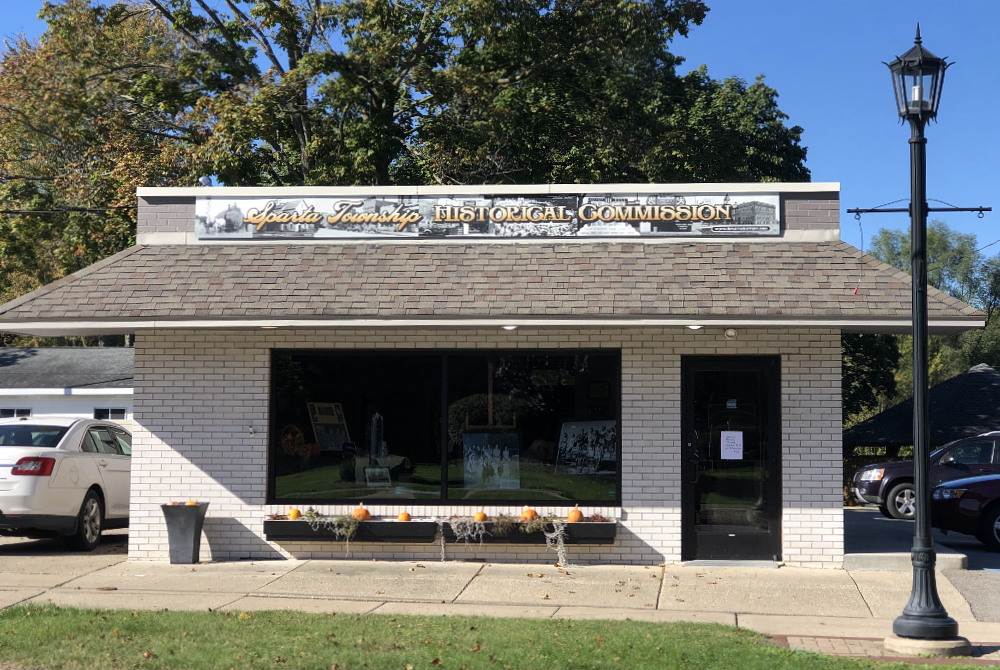
Sparta Township Historical Commission headquarters at 71 North Union Street
Our History Center is conveniently located at 71 North Union Street in downtown Sparta. Please join us for coffee and lively conversation on Monday mornings. Visits to the History Center can also be scheduled by appointment, for your convenience.
We do not receive mail at the History Center, instead, please use our mailing address, which is:
attn: Sparta Township Historical Commission
Sparta Township
160 E. Division St.
Sparta MI 49345
Our complete archives are now available online for your convenience. Just click STHC PastPerfect Catalog Access and begin your research!
For other inquiries, the Sparta Township Historical Commission can be reached by phone at: (616)606-0765 or via email at the following address:
